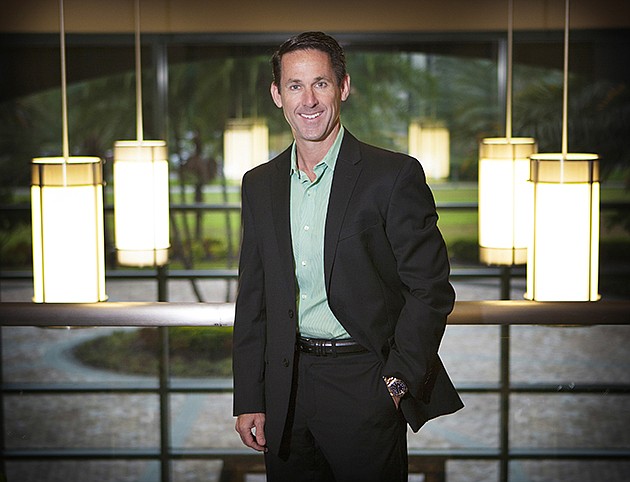Executive Summary
Issue. Growth Industry. Digital Marketing Key. Learn from your failures
Kevin Hourigan, president and CEO of Bayshore Solutions, has grown his Internet marketing business to service 1,900 companies in 54 countries. The 65-person company has offices in Tampa, Colorado and South Florida.
The company, which provides Web design, development and search marketing services, earned $10 million in annual revenue last year and is on track to continue its double digit growth rate year over year. In 2005, the company was named as Microsoft Global Partner of the Year. It's also the only Florida company to make Ad Age's list of top interactive firms 11 years in a row.
Bayshore Solutions' 2015 business plan includes 24% growth and forecasts its highest ever net margin, driven by increased efficiencies from new enterprise software and an increase in rates starting this July.
But it hasn't always been easy for Hourigan. In fact, he'll be the first to tell you that he learned business the hard way. But, he says, “Adversities create the character. Adversities create the opportunity to learn.” Hourigan spoke with the Business Observer before presenting at a Tampa Bay Innovation Center Tech Talk. These are the lessons he shared.
Provide good customer service
One of Hourigan's early jobs was for the company that owns Ritz-Carlton, working the front desk. To this day he credits the experience for why he rarely forgets people's names.
Find the right fit
Hourigan made it his goal to work his way to the top at the hotel. He got to the No. 3 spot, and realized he didn't want to do what No. 1 or No. 2 were doing, so he began looking for a different career.
He started his own computer business, working more than 65 hours a week. He was offered a chance to sell the company, which Hourigan calls a “blessing in disguise” because he got to have a life again.
He got a job at a technology firm and set a record for sales within his first year. He was offered to become a one-third owner of the company, but decided to step away because he didn't think the company had the best ethics or integrity.
Don't give up
In January 1996, Hourigan launched Weblink Communications when the Internet was “not something people knew about,” he says.
The company started as three employees building three-page websites for $500.
Hourigan pitched the business to 100 customers. He says the first 99 said 'no,' and one said 'yes.'
Be careful with intellectual property
In 1999, Weblink Communications grew to 30 employees with an average transaction of $7,500.
When the company expanded to California, it received a cease-and-desist letter that its company name was trademarked by another firm. “It was really expensive and really embarrassing,” Hourigan says. So he changed the company name to Hydrogen Media.
Success doesn't come this fast
By 2000, Hydrogen Media quickly ramped up to 225 employees servicing a $216,000 average engagement with each client.
Hourigan and the leadership team decided to take the company public. He took the $16 million company on a roadshow in Boston.
“Profitability was not the priority. Market share and brand awareness were,” he says. Turns out, the company was overvalued on Wall Street, determined only by the number of its billable staff multiplied by expected revenue of each person.
Hourigan remembers sitting on a jet discussing yachts with the company's financial advisers and something didn't feel right. “Success doesn't come this quickly,” he says. “Businesses don't go from zero to bazillions.”
He realized that going public meant decisions were being made for investors, not necessarily what was best for the company. “Executors of Deutsche Bank wanted us to deviate from our core mission and values to please investors,” he says.
Worst year of his life
In March 2000, the dot-com bubble burst. Hydrogen Media's initial public offering kept getting delayed. “I was on the doorsteps of Wall Street when that happened,” Hourigan says.
The fall in Web businesses meant many of Hydrogen's customers no longer had capital to pay for their services, so they had to drop them.
All of Hydrogen Media's employees had stock options that suddenly didn't amount to anything. The company went from 225 employees in six offices to 11 employees in one office in 11 months. “I had to layoff 150 people, the others saw the writing on the wall,” Hourigan says.
On Christmas Day, Hourigan went to the hospital, thinking something was lodged in his throat, and found out he had six ulcers from all of the stress. “It was the worst year of my life,” he says.
Starting from scratch
The dot-com bubble was all “sprint, sprint, sprint,” but after the bubble exploded, Hourigan had to come up with a “crawl, walk, run” business plan.
Hourigan says the company had to re-identify; it didn't want to be in a “speculative” business anymore. The new business plan depended on 20% year-over-year growth.
In January 2002, Hourigan launched Bayshore Solutions. He picked the word “solutions” because he didn't know where the industry was going and he didn't want to pigeonhole the company.
Watch the bottom line
Hourigan learned that it doesn't always matter what revenues are if the bottom line isn't healthy. He says 2009 was the company's most profitable year, even though revenue growth was the lowest. “If you're unable to grow the top line, work the bottom line,” he says.
Learn from others
Hourigan pays around $12,000 a year and dedicates a half day each month to CEO peer groups. He's participated in Young Presidents' Organization (YPO), Vistage, and Renaissance Executive Forums. “The lessons I've learned saved me way more,” he insists.
He also hired a CEO coach. He always “viewed delegation as pushing crap sandwiches on someone else.” But now, he understands “delegation is part of your job to grow people to grow the company.”
The key to delegation is willingness to accept the worst consequence, he adds.
Be transparent
Bayshore Solutions has one, and only one, business plan. There's no such thing as making lofty goals but then having a back-up plan if it doesn't work out.
With 65 employees, Hourigan lets the whole company know revenues, growth and net income. There are no secrets.
Avoid chasing shiny objects
The industry is full of new tools that could be the next trend in digital marketing. “If you chase after the shiny dazzling objects, they'll probably fizzle out. If you live on the accolades of the past, you'll probably become obsolete,” Hourigan says. The key is finding the right balance of the two.
Four years ago, when QR codes were the big fad and Hourigan had customers begging to spend money on them, he decided not to jump on the bandwagon. He says it was one of his best decisions.
However, the mobile evolution has been one shiny object worth pursuit, Hourigan says.
Find the ideal customer
Bayshore's customers typically boast between $10 million and $750 million in annual revenue, and come from almost any vertical outside of manufacturing. About 20% of the business comes from Carnival Cruise Lines.
So what makes a good customer for the business? Experience working with digital agencies, says Hourigan. “Otherwise we spend more time convincing” the customer that the strategy is sound, he adds.
Today, the annual value of a customer is $150,000 for Bayshore Solutions, with investments in different service areas such as website development and digital advertising.






